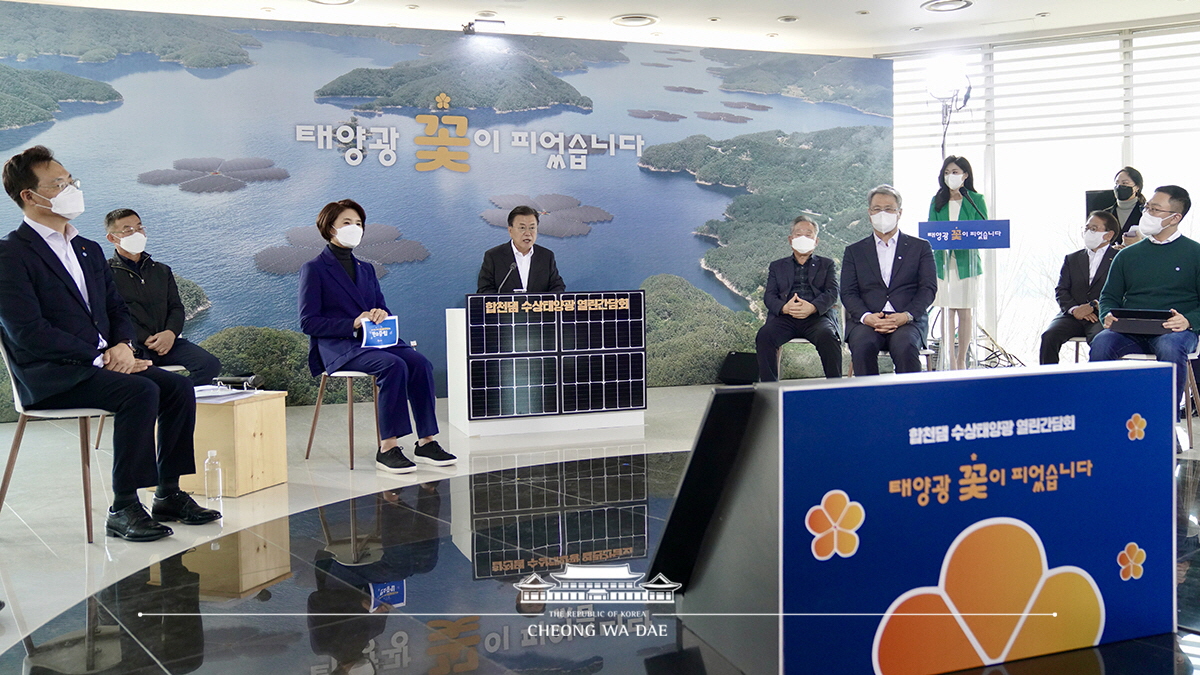이 웹사이트는 제19대 대통령 임기 종료에 따라 대통령기록관이 「대통령기록물 관리에 관한 법률」에 의해 이관받아 서비스하는 대통령기록물입니다. 자료의 열람만 가능하며 수정 · 추가 · 삭제는 불가능합니다.
다만, 「개인정보보호법」에 의하여 개인의 정보를 보호받기 원하시는 분은 관련 내용(요청자, 요청내용, 연락처, 글위치)을 대통령 웹기록물 담당자(044-211-2253)에게 요청해 주시면 신속히 검토하여 조치해 드리겠습니다. 감사합니다.
SPEECHES & REMARKS
BRIEFINGS
Remarks by President Moon Jae-in during Visit to Floating Photovoltaic (PV) Power Plant at Hapcheon Dam

Fellow Koreans, residents of Gyeongsangnam-do Province and Hapcheon-gun County,
The three peaks of Hwangmaesan Mountain reflected on Hapcheon Lake form the shape of a plum blossom. Sprawled on the surface of this lake are photovoltaic panels that also resemble plum blossoms from an ink-and-wash painting. The Government and a private company as well as local governments and residents have worked together to bring forth a floating photovoltaic power plant, a new private-public cooperation model. Finally, Korea’s greatest and the world’s 10th largest floating photovoltaic power plant has begun to generate electricity. I extend my congratulations to the residents of Gyeongsangnam-do and Hapcheon-gun who have come together. I am grateful to everyone involved in producing dedicated photovoltaic power plant modules completely with our own hands by employing world-class technological expertise.
The key to 2050 carbon neutrality is an energy transition. Since the Paris Agreement was ratified, countries around the world have put 66 percent of their energy facility investments into renewables. Among them, photovoltaics are drawing keen attention as the most important source of renewable energy. In particular, floating PV power plants on reservoirs behind dams are being hailed as eco-friendly because they require neither additional civil engineering nor deforestation. Moreover, they are highly efficient at generating power due to the cooling effect of being on water.
Our PV power plants have great potential – generating as much as 9.4 gigawatts of electricity – equivalent to the total amount of electricity generated by nine nuclear power reactors. The floating PV power plant at Hapcheon Dam will generate 41.5 megawatts of electricity annually, which is the same amount of power used in one year by 60,000 people, more than the total population of Hapcheon-gun. As Korea’s largest floating PV power plant at a multi-purpose dam, it can provide 73 percent of Hapcheon-gun’s total electricity needs and help reduce 26,000 tons of greenhouse gas emissions and 30 tons of fine dust.
Countries around the world are also beginning their development of floating PV power plants at multi-purpose dams. At COP26 held in the United Kingdom last month, Indonesia, China, Viet Nam and several other nations showed considerable interest in our floating PV power plants. We agreed to proceed with a joint project with Indonesia. Going forward, officials from many countries will come to Korea to see firsthand and learn from this floating PV power plant at Hapcheon Dam.
It will be a huge boost for the local economy as well. A total of 76.7 billion won was invested in the Hapcheon Dam floating PV power plant, which can earn 12 billion won in annual revenue by selling electricity. More than 1,400 residents in 20 nearby villages who contributed to the investment will receive annual returns of up to 10 percent over the power plant’s 20 years of operation. It will be the first floating PV plant pension in Korea for participating residents.
We are at the starting line, poised to leap forward from a nation on the periphery in terms of energy – one which relied on other countries for most of its energy sources – to an energy self-sufficient country. Hapcheon will become the center of the Republic of Korea’s energy transition in the era of 2050 carbon neutrality.
The Government will spread the examples set by the Hapcheon Dam floating PV power plant. Bold investment will be made by focusing on our strengths while safely maintaining the unique function of dams and preserving the beauty of natural scenery. We will work together with local residents from the planning stage and design projects in ways that ensure the profits from power generation can be returned to them. New and renewable energy will account for up to 70 percent of our power generation by 2050 through the expanded use of eco-friendly energy sources that suit our environment.
Residents of Gyeongsangnam-do and Hapcheon-gun,
Local residents are both the source of power that created the Hapcheon Dam floating PV power plant and the leaders who will spearhead the energy transition. Thanks to Hapcheon-gun residents who understood the need for an eco-friendly energy transition and proactively took action, we were able to proceed with the project quickly. This new model for sharing profits with local residents has firmly established them as owners of local energy.
The Hapcheon Dam floating PV power plant’s panels resemble plum blossoms. The people’s interest in and expectations for “nature-assimilating technology” have grown. Picturesque Hapcheon’s aquatic scenery will become a more beautiful tourist destination with the addition of this trail of floating plum blossoms.
Local residents and various experts are with us today to share their experience and know-how. I hope that this will serve as an opportunity to confirm the viability of a resident-driven energy transition and help spread it nationwide.
Thank you.



